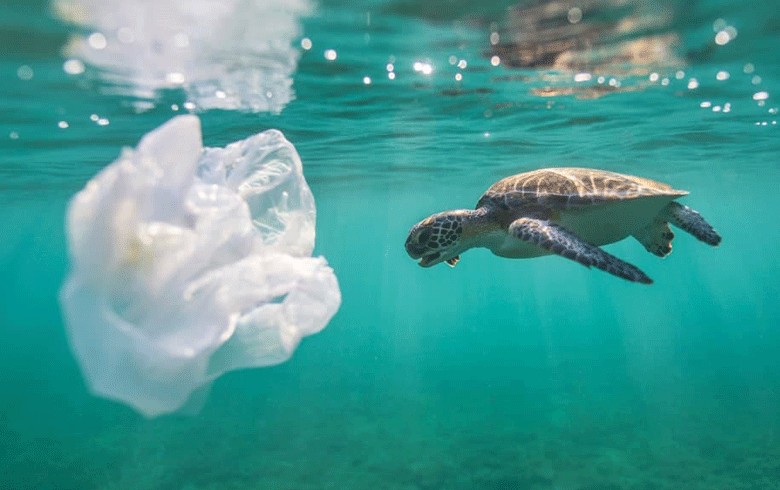Oh, no! You got distracted and left the water running in the bathtub. You run into the bathroom, see it overflowing onto the floor, and you turn and run for a mop.
A mop? No, you don’t run for a mop, says Jackie Savitz, chief policy officer for Oceana. You turn off the faucet.
Savitz and Oceana’s CEO, Andrew Sharpless, were panelists at College of the Atlantic’s Summer Institute series, and the above analogy was employed to make the case that ridding oceans of plastic means stopping production, not cleaning up the mess.
“The only way to solve this problem is to frame it as a pollution problem.”
The plastics industry, Sharpless said, wants to direct people toward finding “a really good mop,” rather than closing the tap. “That’s the metaphor that makes sense to us.”
In their discussion on July 27, Sharpless and Savitz fielded questions from moderator and Washington Post reporter Frances Stead Sellers about emerging technologies that either remove plastics from the ocean or somehow mitigate their effects. They dismissed the ideas as distractions to the actual threat.
“They’re just really not practical,” Savitz said.
Plastics don’t break down into basic chemical building blocks, Savitz said, but rather, “They keep breaking down into smaller and smaller pieces.” Those particles of plastic—which retain their molecular structure—are being found throughout the marine food chain.
“It’s still plastic,” Sharpless said.
“This is a massive crisis,” Savitz said, with 33 billion pounds entering the ocean each year, the equivalent of two dump truck loads every minute.
Along with plastics manufacturers opposing restrictions, petroleum producers also are working to divert public attention, they said.
Those producers see a shrinking market for their fuel as transportation and electricity generation turn to renewables.
“That’s why we’ve seen massive new plastics factories proposed for all over the country,” Savitz said.
And in addition to the health concerns for humans—some plastics are estrogen mimickers and cause cancer in reproductive organs—and the harm they cause marine organisms, plastic production is the fifth largest generator of greenhouse gases.
The challenge on the policy front is countering the narrative that consumers must take responsibility.
“It’s your fault, consumers,” is the message, Savitz said.
“There is a big struggle on how to frame the problem,” Sharpless explained, with some arguing that waste must be better managed.
But Oceana rejects this approach.
“The only way to solve this problem is to frame it as a pollution problem,” he said.
Recycling plastic is not a solution, they said, because it degrades in subsequent applications. About 9% of plastics are said to be recycled, but Sharpless said the actual amount may be closer to 2%.
“They mislead us on that,” he said.
Another reason to be skeptical about efforts to remove, for example, the giant “island” of floating plastic in the Pacific as a solution is that plastics have been found throughout the water column and on ocean bottom.
Savitz noted that other contaminants in water bodies have been addressed differently than plastics. When mercury was identified as a neurotoxin and laws changed to prevent it ending up in the environment, “We don’t talk about, ‘Let’s go out and clean up the mercury that’s out there,’” she said.
Packaging accounts for about 40% of plastic, they said, and therefore is a likely first target for regulation. Two years ago, Maine passed legislation creating an “extended producer responsibility,” similar to what is mandated for manufacturers of tires, batteries, and mattresses.
“We want to put this problem back on the producers,” Savitz said. Legislation can force manufacturers to pay into a clean-up fund, collect used plastic, and reduce production.
California and Oregon also have passed producer responsibility laws, with the California law requiring a 25% reduction in plastic packaging by 2032. Sharpless noted that European Union and Chile also have taken strides toward restricting production.
The private sector also may be changing direction. Sharpless said Coca-Cola, which is responsible for 22% of the world’s plastic containers, is aiming to have 25% of its product in refillable containers by 2030.
And Amazon is facing pressure to change, with 48% of shareholders voting in April to have the company publish its “plastic footprint.”
Oceana, which describes itself as a global advocate for the health of the oceans, has protected 4 million square miles of habitat around the U.S., United Kingdom, Belize, and other nations.





